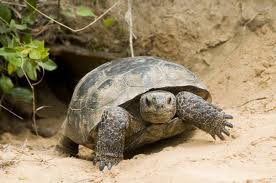
by Will Sheftall | Oct 26, 2014
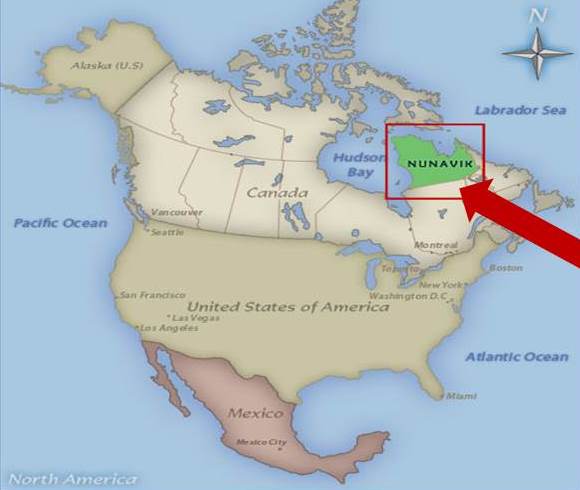
“Within the past five years, nine of the 14 villages in Nunavik in northernmost Quebec have had to install cooling systems at community ice hockey arenas to keep the rinks cold during winter.“
– The Arctic in the Anthropocene: Emerging Research Questions
Have you wondered how Florida’s wildlife conservation policy planners and habitat managers are responding to the new management challenge of predicted coastal habitat loss from sea level rise? And how that overlays on predicted habitat loss from a 50-year doubling of Florida’s human population? Are the model predictions for both trends reliable enough to give planners a platform for recommending actions to ensure a habitable Florida for wildlife and for our grandchildren?
It’s a daunting task. The latest reports released by the Intergovernmental Panel on Climate Change (IPCC) [ http://www.floridaclimateinstitute-uf.org/new-ipcc-report-climate-change-2014-impacts-adaptation-and-vulnerability/ ] serve to compress our “breathing room” of time to shift gears into planning for a “multiple-whammy” future – a future that just a decade ago, few natural resource managers knew they would soon need to anticipate. How do we juggle explosive population growth, accelerating freshwater depletion, and rapid climate change? What initiatives and efforts are underway?
To answer this question, let’s turn to Dr Thomas Eason, Director of the Division of Habitat and Species Conservation at the Florida Fish and Wildlife Conservation Commission (FWC). Dr Eason gave a talk on campus a year ago at the UF/IFAS conference, “Sustaining Economies and Natural Resources in a Changing World.” His 25-minute presentation, “Florida Fish and Wildlife – Adapting to a Changing World,” was recorded and posted at [ http://training.ifas.ufl.edu/FCI2013/Session4_Natural_Resources_Eason/main.htm ]
Eason noted that globally, climate change is predicted to result in the extinction of 10-40% of all wildlife species. FWC has generated vulnerability assessments for a first suite of rare and imperiled species, and some non-native invasive exotic species as well. Analysis has shown that for many non-native species in Florida, climate change will create new habitats, and they will expand their range, while imperiled species will more likely experience shrinkage of habitat that is already inadequate.
Eason noted that sea level rise will directly impact “tens of thousands” of acres of Florida habitat, and that consideration of secondary and tertiary impacts had yet to be addressed by habitat planners. Species adaptation planning has been undertaken in collaboration with GeoAdaptive (formerly MIT). Thus far, the initiative includes future habitat modeling for six South Florida species for which FWC has good data, under three different scenarios for sea level rise.
Eason concluded with the metaphor that society (and the natural resource conservation professions) are in a car he called “Business-as-Usual” (BAU) colliding in slow motion with a wall (future reality), and that even if we don’t know it yet, BAU is “already blowing up” because “humans have put things in motion that are not going to stop”(changes in technology, demographics, the economy and climate) that will make our world 50 years hence radically different from today’s world.
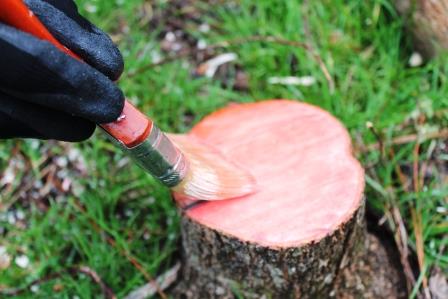
by Mark Mauldin | Feb 20, 2014
As Floridians we often struggle to find any upside to these cold, gray days we’ve been experiencing past few months. As “unfloridian” as our winters can be they pale in comparison to those endured by the more northern states. In fact, the last days of winter can be the ideal time of year in the Panhandle to tackle some outdoor chores like controlling unwanted trees and other woody plants.
Controlling trees can be hard work, the cooler temperatures can make the task a little less taxing. The relative inactivity of the “creepy crawlies” and pests often found in wooded areas is another reason to consider completing tree and woody plant removal projects during the winter.
Tree control generally involves mechanical removal. In some cases mechanical removal provides only short term control; in other cases it can actually increase the number of unwanted plants over time. This is the problem with both Chinese tallow (popcorn tree) and privet. Herbicide treatments can eliminate the possibility of regrowth and provide permanent control. The herbicide application techniques used to control trees and other woody plants are very selective and they are effective during the winter. These techniques provide opportunities to use herbicides in a controlled and very targeted manner with very little risk to surrounding plants. Additionally, the techniques below are most effective through the fall and winter when sap flow in trees is lessened.
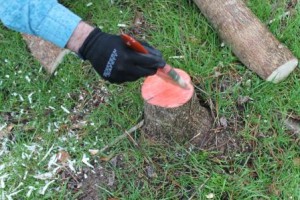
For best results the cut stump treatment should be done immediately after the tree has been cut down. Photo courtesy of Mark Mauldin.
The cut stump technique is a fairly common and very effective method of achieving permanent control of woody plants. As the name implies, the first step in the cut stump technique is to cut down the tree. Immediately after cutting down the tree spray or paint the stump with herbicide. On smaller stumps the entire surface should be covered with herbicide; on larger stumps effective control can be achieved by only covering the outside three inches of the stump.
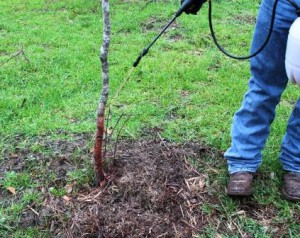
With the basal treatment, cover the bottom 12 to 18 inches of the tree with the herbicide oil mixture. Be sure to cover the entire circumference of the tree. Photo courtesy of Mark Mauldin.
Two additional herbicide application techniques that work well on woody plants do not require the plants to be cut down first. The basal application technique works best on smooth barked woody plants with a diameter of less than six inches. This technique involves spraying the bottom 12 to 18 inches of the tree with an herbicide oil mixture.
The hack and squirt method works well on large and/or thick barked trees. This technique involves using hatchet or other tool to cut through the bark around the circumference of the tree, then applying herbicide directly to the cut. Several months should pass between herbicide application using either of these techniques and mechanical removal.
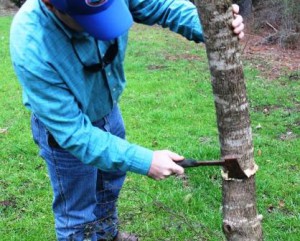
The hack and squirt treatment is best for large and/or thick barked trees. Photo courtesy of Mark Mauldin.
Be sure to read and follow the label of any herbicide you use. Always wear the proper personal protective equipment. For more information on the techniques described, including recommended herbicides and rates, read Herbicide Application Techniques for Woody Plant Control or contact your county’s UF/IFAS Extension Office.
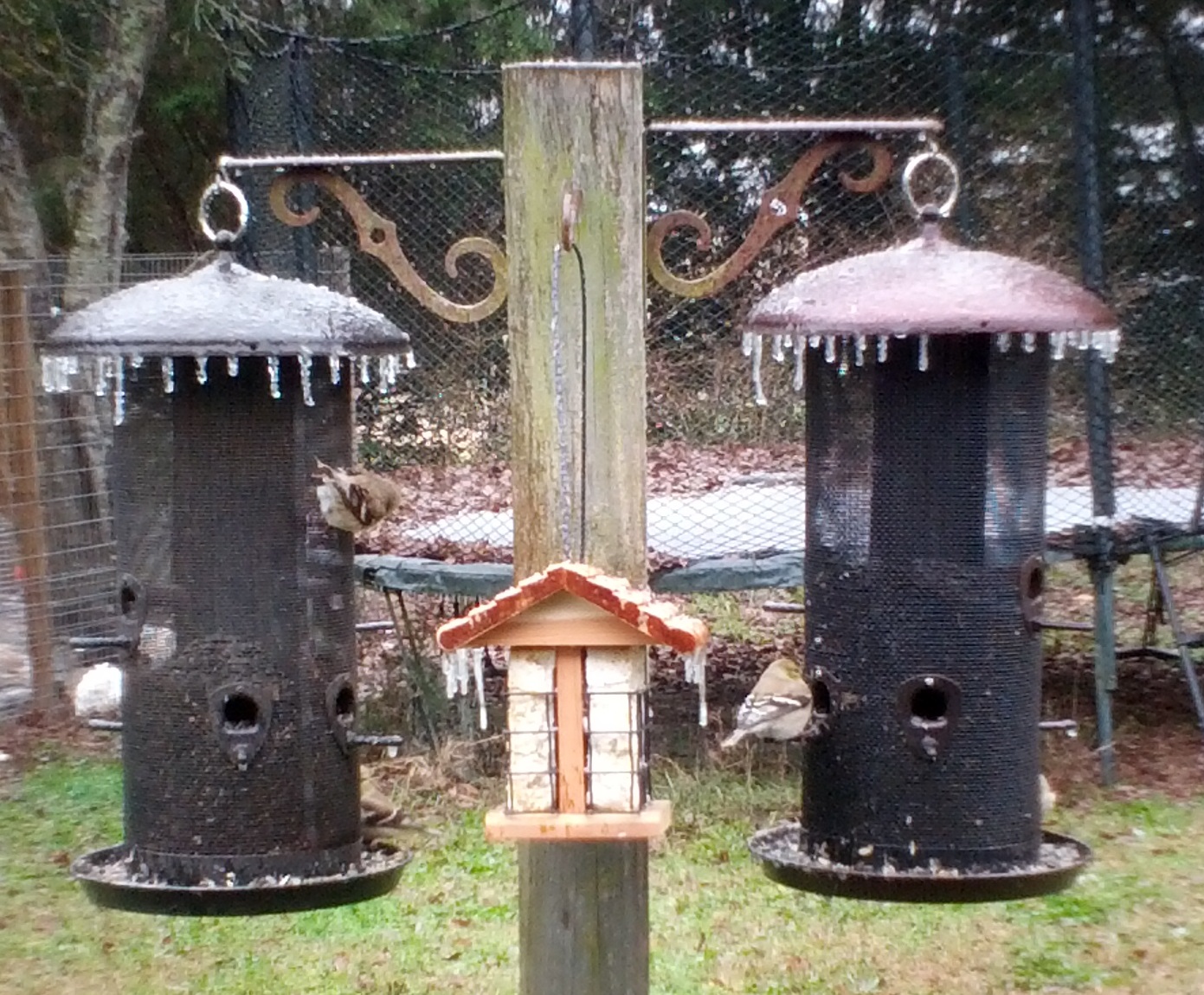
by Judy Biss | Feb 2, 2014

Even though adapted to weather extremes, these migratory American goldfinches (Spinus tristis) appreciated the food and cover provided in this backyard. Photo by Judy Ludlow
North Florida experienced a weather delight (or distress depending on your point of view!) this week in the form of freezing rain and snow! The words “Florida” and “snow” are two words most people would not place together in the same sentence, but you may be surprised to learn that snow has been documented a number of times in Florida as revealed by records as early as 1891. In Tallahassee, measurable snow has not fallen since 1989.
The following information is taken from the National Weather Service Weather Forecast Office Tallahassee, FL about the history of Snowfall in Tallahassee: Several winters ago, NWS Tallahassee Climate Focal Point, Tim Barry, responded to an inquiry from a reporter concerning snow climatology in Tallahassee. Some of those questions and answers are listed below.
In ten-year intervals, how many times has it snowed in Tallahassee Florida?
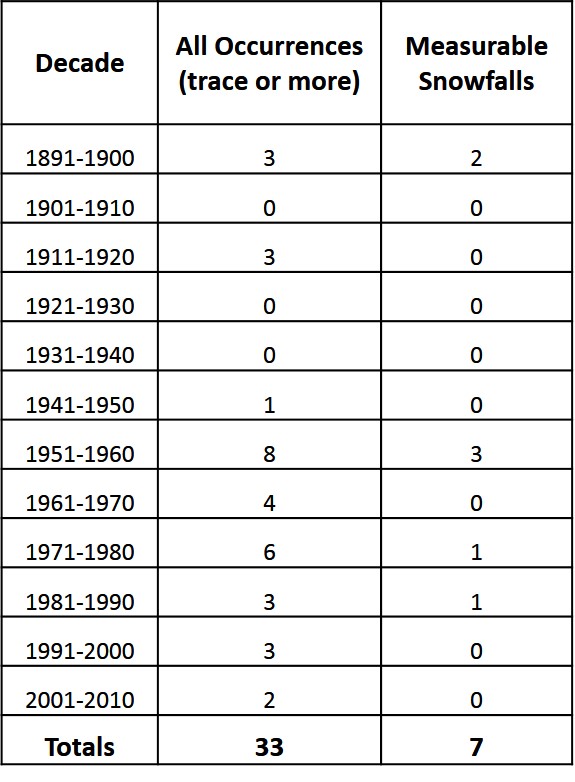 How frequently does Tallahassee see snowfall?
How frequently does Tallahassee see snowfall?
From the information provided in the 1st question, we see that it snowed 32 times in Tallahassee since 1891. Please note that all but 7 of these occurrences were only Trace amounts. If we were to divide the period of record (117 years) by 32 we would get a frequency of once every 3.66 years. But as you can see from above, the more frequent occurrences of snow in the 50’s ,60’s and 70’s have skewed the results. The return period for measurable snow is just once every 17 years. The most snow recorded in a 24-hour period was 2.8″ from February 12th – 13th, 1958.
Any interesting or exciting facts about Tallahassee winters?
There is a significant difference between the climate of north Florida and the southern portions of the peninsula. On average, we experience 35 days with minimum temperatures at or below freezing with most of these occurring from December through March. The coldest temperature ever recorded in Tallahassee was -2 F on February 13th 1899. More recently, we dipped down to 6 degrees F on January 21st, 1985.
Florida’s wildlife, although adapted to Florida’s weather, will thrive given the added boost of backyard habitats planned for their benefit, especially during these winter weather extremes! During the winter, Florida’s native, resident, wildlife species are also joined by species which are here temporarily as they migrate through our state. The hundreds of American goldfinches (Spinus tristis) outside my window are one example.

Do you see the red cardinal in the shrub? A variety of cover strategically placed near food sources helps minimize predation and provides protection from weather extremes. Photo by Judy Ludlow
When growing your backyard habitat, think about recreating features which are naturally provided in undisturbed habitats, but only on a smaller scale. To flourish, wildlife need adequate nutritious foods, functional cover, and clean water. Locating food close to cover minimizes the exposure of foraging wildlife to severe weather conditions and to predation; these two factors account for a large percentage of mortality. Cover comes in the form of trees, shrubs, brush piles, etc. of varying heights and sizes.
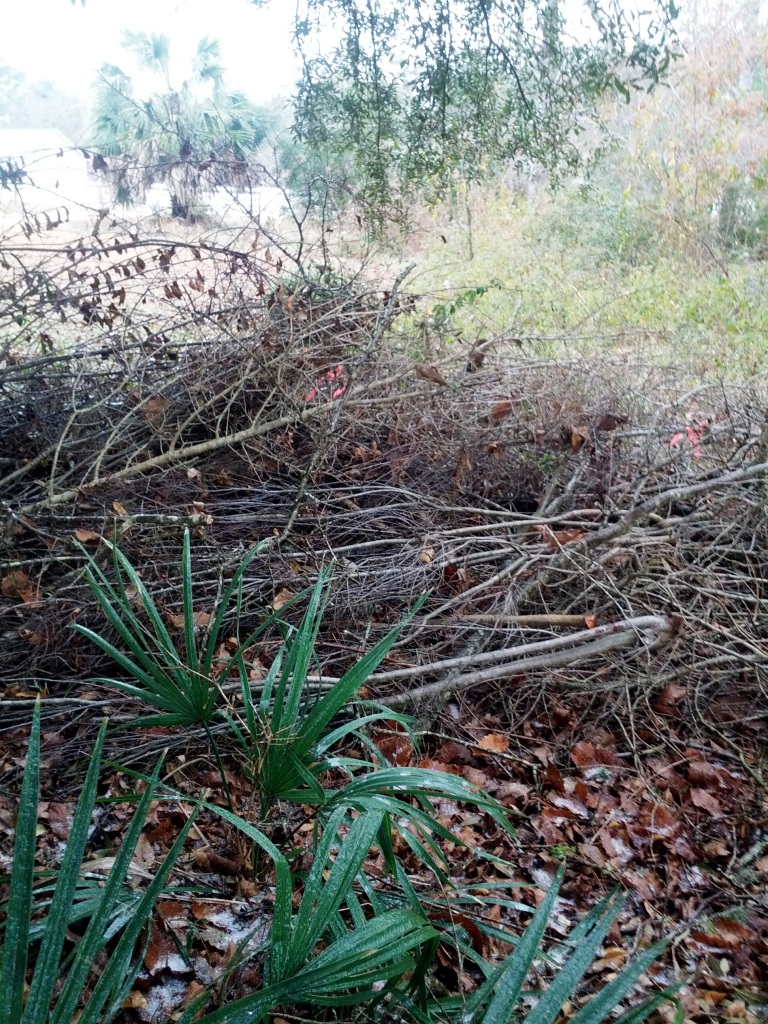
Brush piles such as this one provide valuable wildlife habitat for many species. Photo by Judy Ludlow
The following information is from the Florida Fish and Wildlife Conservation Commission’s publication: Planting a Refuge for Wildlife.
Cover: Breeding, nesting, hiding, sleeping, feeding and traveling are just a few of the necessary functions in an animal’s life which require protective cover or shelter. Often plants used for cover double as food sources. Strategic placement of cover is very important in that it reduces exposure to weather extremes and provides escape from predators.
Food: All animals get their energy for survival from plants or other animals. The ideal wildlife management plan uses natural vegetation to supply year-round food – from the earliest summer berries to fruits that persist through winter and spring (such as sweetgum, juniper and holly). You will attract the widest variety of wildlife to your land by using native plants to simulate small areas of nearby habitat types. The “edges” where these habitat types meet will probably be the most visited areas in your neighborhood.
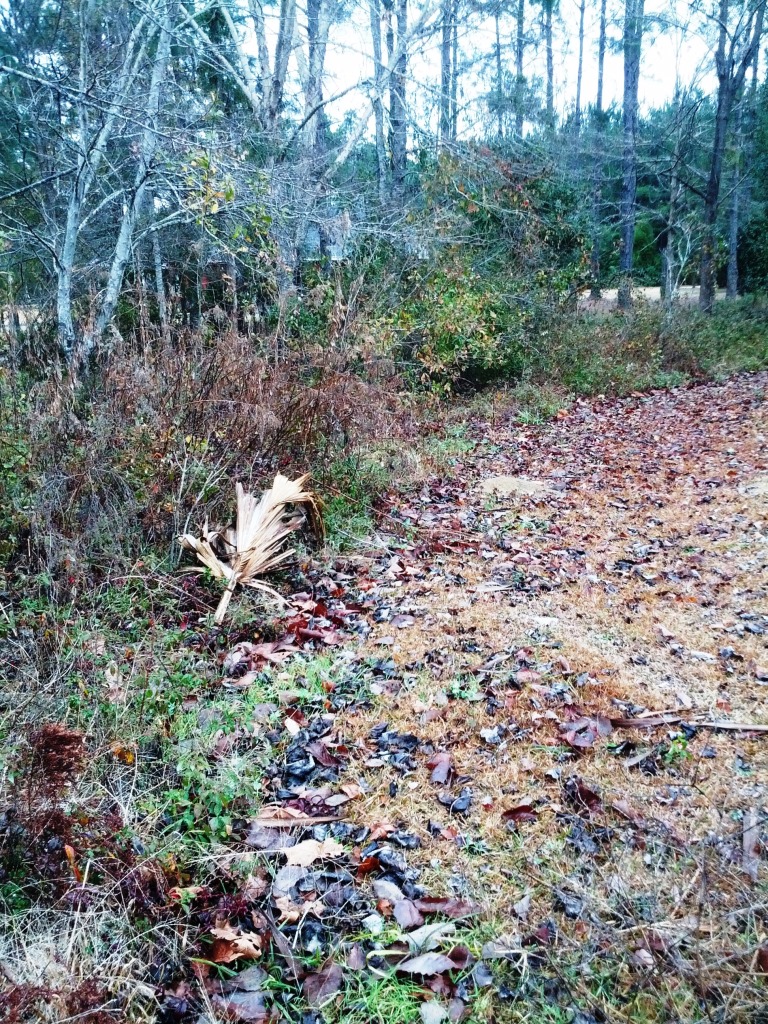
The boundary between two habitats such as between this lawn and small wooded area, creates an “edge effect” which is important to wildlife. Photo by Judy Ludlow
If you are interested in learning more about this topic, please read the following publications and, as always, please contact your local UF/IFAS Extension Agent if you have any questions.
Planting a Refuge for Wildlife
Landscaping for Wildlife
A Drop to Drink
Eight Ways to Double the Bird Species at Your Feeders
Landscaping for a Song
Making Your Backyard a Way Station for Migrants
On Your Own Turf
Plant Berry Producing Shrubs & Trees
Plant Wax Myrtles
There’s Life in Dead Trees











